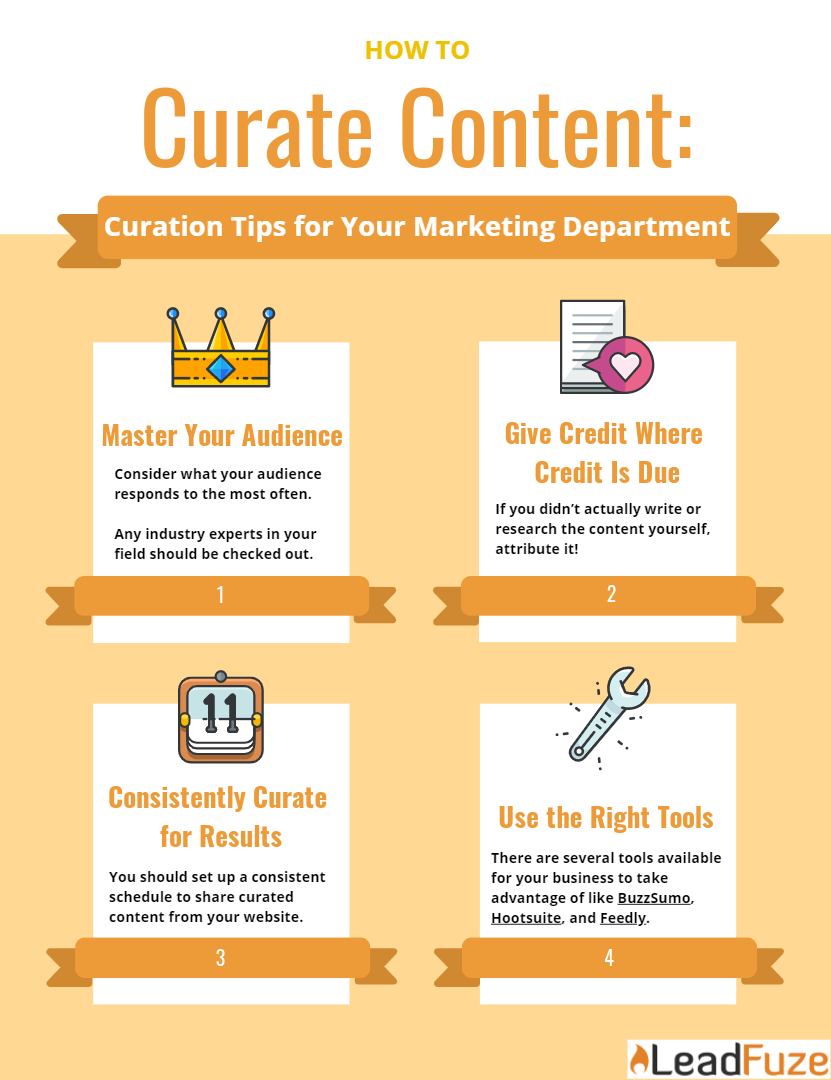6 Benefits of Content Curation
Content curation can be done in several ways. You can air a recording of someone’s speech on a podcast or webinar, quote someone in a blog post, share another person’s article on Facebook, retweet someone’s tweet, or publish a customer’s video testimonial on your homepage.
So content marketers, news media, and entertainers all practice content curation in some shape and form. It is popular because it has many advantages. Here are a few benefits that marketers can enjoy when they curate content:
1 Increases your content velocity
Creating content takes a lot of time and effort. To increase the amount of content you publish and save time for other areas of your business, it may be helpful to put your own spin and share content people in your industry have already published.
2 Validates new content ideas at minimal expense
Content curation allows you to explore topics you may not have found time for yourself and can help you discover and validate your audience’s other interests. If a piece of content you curated resonates with your audience, you can then decide to carry out your own original research and share a unique perspective with your own content. When it comes to using existing content to share a unique perspective, utilizing paraphrasing manually or with online paraphrasing tools could be an easy option to go for. An AI paraphrasing tool paraphrases content in different ways while keeping its actual meaning. This will help you get new ideas for the curated content in an easy and quick way
3 Streamlines content creation
There’s a lot of content out there, and most of it isn’t all that helpful. By curating content and organizing it in a way that makes reading and digesting information easier, you’re making your insight useful to your target audience.
4 Enables the sharing of alternative perspectives
Let’s face it: nobody wants to read about how great your products/services are 24/7. Curating content that already exists gives you the unique opportunity to share multiple perspectives, even if you don’t necessarily agree with every viewpoint.
5 Showcases alternative opinions
As marketers, we tend to obsess about ourselves and our products. Customers can get sick of this. By showcasing other people’s viewpoints, you show your audience that you are not self-absorbed and want them to form well-rounded perspectives that are informed by different opinions.
6 Corrects common misconceptions
By showcasing other perspectives, you also get to respond to and respectfully correct misconceptions around your product in a way that is not defensive. It allows you to add your own voice to trending issues and show your audience that you are informed.

How to Curate Content The Right Way – 4 Tips for Success
The best way to learn about curating content is by reading content written by other people in your industry. You’ll notice what they do differently and their viewpoints on certain subjects. This is how you discover content that is worthy of curation.
In a way, content curation is an exercise in sorting through the plethora of existing knowledge and information and presenting it in a way that’s fresh and unique and which can help your audience.
At the end of the day, the purpose of content curation is to educate your audience. The content you share must help them accomplish tasks, improve their lives, or solve problems they are struggling with.
On that note, here are content curation best practices to remember the next time you retweet someone’s tweet, republish another site’s blog post, publish a testimonial, or quote someone in a blog post.
1 Master your audience
Before you get started on the process of curating content, you need to know who the audience is, and what they’re expecting from you.
For example, if you’re traditionally a CRM software developer, your audience is marketers, sales managers, and customer service specialists. Study this audience to learn what they are interested in reading before you curate content for them.
If you’ve developed a following on your blog or through social media, consider what your audience responds to the most often. These are the types of articles and content pieces you should be looking at curating.
Additionally, check out what industry experts in your field are actively writing about. They will typically share news and insights about developments within the industry. These are usually worth sharing.
2 Acknowledge the original creator
Don’t publish curated content as your own. If you didn’t actually write or research the content yourself, attribute it to the person who did. Before you pass others’ content as your own, consider someone doing that with your original content. You obviously wouldn’t like it.
Time and time again, I see businesses attempting content curation, but failing in this regard.
You’re simply collecting the content and repurposing it for your readership. Out of respect and professional courtesy for the person who initially wrote the piece, always acknowledge them when you share their content. If it’s a blog post, why not link out to the original post?
3 Curate consistently
Like with most things, when it comes to marketing, consistency is key.
Content curation shouldn’t take nearly as long as it does to research and write your business’s own unique content.
As such, you should be able to set up a consistent schedule to share curated content on your website, whether it’s weekly or bi-weekly. By having a consistent schedule in place, your readers will know when to check out your site for newly-released content.
4 Use the right tools
I get it: curating content manually can be time-consuming and overwhelming. Not everybody has the time to endlessly scroll through Google or industry websites searching for quality content to curate.
Fortunately, there are several tools available for your business to take advantage of. These include:
- BuzzSumo – The tool allows you to find the most shared content and key influencers in your unique industry. BuzzSumo is also a great way to leverage social media in your content curation process since that’s where you’ll likely find a lot of the influential content you’re hoping to share.
- Hootsuite – Lets you quickly peruse any and all social channels for mentions and hashtags frequently used online. If you have a specific niche industry in mind, utilizing Hootsuite for topic ideas can be helpful.
- Feedly – Gives you the ability to aggregate and organize RSS feeds of content. If you’re perusing the internet regularly, Feedly offers a quick way to organize and keep track of interesting articles for later use.
- ContentStudio – You can easily create engaging and relevant content. Explore and collect trending content with the Content Discovery module and maintain a steady stream of curated content. Select topics of interest and see pertinent articles in your daily feed based on a sophisticated scoring algorithm. Select those most aligned with your business and likely to boost engagement. Increase traffic and conversions by instantly curating, effortlessly publishing, and promoting content your audience craves.
These tools ensure content curation efficiency, but they will also help you stay on top of trends. They help surface trending content, which is always a great option for curation. Just be sure to keep it relevant to your audience.
Content Curation and SEO: How to Curate What’s Already Published
When curating content that has been published already, there is a valid concern that you are creating duplicate content that could become an SEO issue.
When done correctly and respectfully, you can mix your original content with the curated content.
Here are a few rules to follow:
Attribute the article to the original author and/or site where you found it.
Remember, your goal should be to curate for your audience, not for the search engines.
Add your own perspective to each curated content piece.
This will make the content on your site unique and not an exact word-for-word copy of the source article. This also allows you to add your two cents and add the voice that your audience is familiar with.
Create a new title for each curated article.
Again, think unique content here. This can help prevent your article from competing with the original article in the search results.
Curate content from different sources.
This should be a no-brainer, but it’s still important to mention. If you curate content from the same source constantly, then you might as well just tell all of your users to visit that other site first in the future.
You don’t want to clone another site’s content as that dilutes the value your curation effort is creating. It can seriously hurt your SEO. Instead, aim to add real value for your readers by curating the best content from a variety of sources.
Mix your original content with the curated articles.
Well-thought-out, original content is not dead. In fact, articles that cover a topic in a new way with an original thought have more potential. It will likely turn into some of your best traffic-driving content.
If curated content isn’t for search engines, that means you still need original content for the search engines to pick up. It’s the combination of the two (curated and original content) that creates a one-two punch that your audience will love.
Next, let’s discuss mistakes you should avoid when curating content:
10 Common Mistakes to Avoid When Curating Content
There are some content curation habits that simply don’t cover you in glory as a content marketer. And the last thing you want to do is come off as shady and unprofessional:
1 Sharing too often
You should never disregard the importance of variety and spacing when it comes to content curation.
Posting the same content 5 times in a row one hour apart isn’t a good practice, as this will only bore your audience. You don’t want them to see only your posts on their feed, or else they’ll unfollow you. And you don’t want that, do you??
2 Sharing content from the wrong creators
If you want to have a successful blog, then you need to find influencers in your niche and promote their work. You’ll get more followers this way because they keep getting inspired by new creators.
For instance, if you’re an interior designer, then find a fashion blogger and share his content. You’ll get more followers in return because people will follow the example of their idol – plus they’ll come to your blog for design advice too!
This comes back to knowing your audience and what they like to watch, read, and listen to.
3 Not posting often enough
People expect that if they follow someone on social media platforms like Instagram or Facebook, they’ll see that person’s posts on their feed. If you don’t post often enough, then your followers will unfollow you and follow someone who does.
Likewise, if you don’t publish enough, people will unsubscribe from your email newsletter. When you’re active, you get more followers, and when they see your latest post on their feed, it’ll motivate them to follow you too!
After all, what’s the point of following someone if there are weeks between their posts. You need consistency so that people know what to expect. If you’re inconsistent, then some days will have no posts at all.
4 Not sharing at all
If you’re not sharing your curated content, it will be difficult for people to find and discover what you’ve found. How would they know you’re an expert who provides reliable information when you don’t share your best content?
5 Not engaging with followers
If you’re not engaging with your followers, then why should they bother following you? It’s important that you reply to their messages and respond to their comments. You must show them they matter to you.
6 Not divulging your content sources
This can prevent other people from discovering the same thing as you did through different points of view on a certain subject, which can be valuable for them.
In fact, there is a very thin line between doing this and passing other people’s content as your own creations. It’s plagiarism and you don’t want to develop a reputation for it.
7 A lack of focus
A blog post that covers too many topics will probably not be as engaging. Some of your followers may not be interested in the other topics you are curating and may tune out as a result.
One post that covers the topics your followers are interested in is better than ten posts no one will read because they are all over the place. So, it’s best to determine the niche your content will be centered on, and focus there.
8 Curating spammy content
Curating poor-quality content that make dubious claims will hurt your brand, if it doesn’t get you in trouble with the law first. It reflects poorly on your site and discourages people from returning in future.
9 Not updating old content
If you publish a blog post, make it a point to return to it and make updates or add new information as necessary. Otherwise you end up serving your audience outdated information that is no longer useful. It hurts your brand’s image.
10 Making your content all about you
Don’t make this selfish mistake. Your content should be about your audience and what information they want to consume.
Publish quality content that’s relevant to their interests and they will reward you with their attention. Always remember that you’re serving them and not yourself.
Simplify Content Curation By Using The Right Tools
What are you using to curate content?
LeadFuze is the ultimate social media management and marketing platform. It’s easy to use, affordable, and powerful. Use it to curate content for social media and to manage your Facebook, Twitter, Instagram, LinkedIn, and Pinterest profiles all in one place!
This all-in-one tool also has awesome features for lead generation, with templates and tools for looking up phone numbers and email addresses.
With LeadFuze everything is easier – from managing posts on multiple networks to finding prospects with our lead generation tools.

Simplify your content curation!
Level Up Your Content Curation Skills
Content curation is a necessary skill to master for busy marketers. It allows you to fill your content calendar with content your audience wants to read, watch, and listen to. That saves you time to work on your offers and other research-heavy content pieces.
When you share content with experts, it makes you appear as an expert yourself. This draws new followers and expands your lead sources.
Remember, however, that there is a right way to curate content. So avoid the mistakes we highlighted and put the tips and best practices we shared to use. That is how you curate content and remain the hero that you aspire to be in your audience’s eyes.
Want to help contribute to future articles? Have data-backed and tactical advice to share? I’d love to hear from you!
We have over 60,000 monthly readers that would love to see it! Contact us and let's discuss your ideas!

